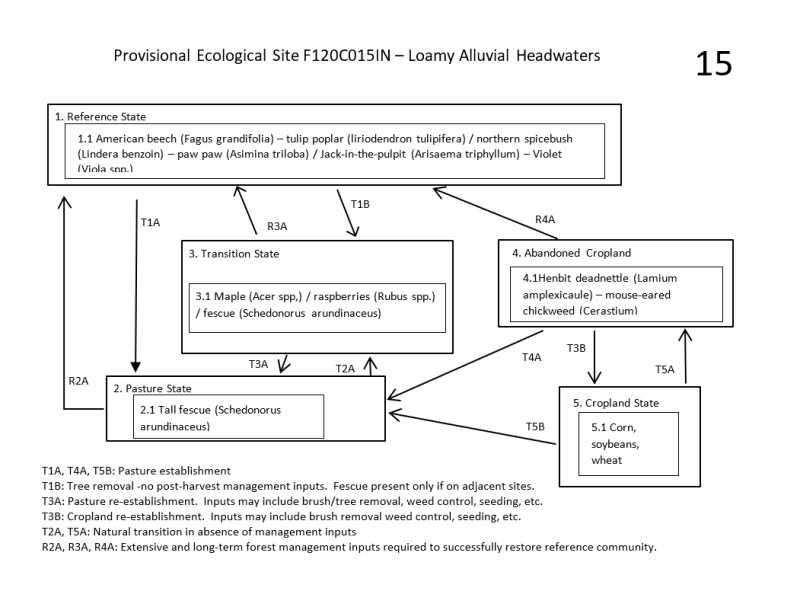
Natural Resources
Conservation Service
Ecological site F120CY015IN
Loamy Alluvial Headwaters
Last updated: 10/01/2024
Accessed: 12/22/2025
General information
Provisional. A provisional ecological site description has undergone quality control and quality assurance review. It contains a working state and transition model and enough information to identify the ecological site.
MLRA notes
Major Land Resource Area (MLRA): 120C–Kentucky and Indiana Sandstone and Shale Hills and Valleys, Northeastern Part
120C—Kentucky and Indiana Sandstone and Shale Hills and Valleys, Northeastern Part
This area is entirely in Indiana and makes up about 1,050 square miles (2,725 square kilometers). Physiography: This area is in the Highland Rim Section of the Interior Low Plateaus Province of the Interior Plains. Both large and small tributaries of the Ohio River and the East Fork of the White River dissect the nearly level to very steep uplands in the area. The major streams and rivers have well defined valleys with broad flood plains and numerous stream terraces. The flood plains along the smaller streams are narrow. Summits are narrow and are nearly level to gently sloping. Geology: The geologic materials in this area are of Early and Middle Pennsylvanian and Late Mississippian age. The rocks consist mainly of flat-lying, interbedded sandstone, shale, coal, and siltstone with minor areas of limestone. Bedrock outcrops are common on the bluffs along the Ohio River and its major tributaries. The surficial geologic materials consist mainly of a layer of loess, typically less than 3.5 feet (1 meter) thick, on the less eroded parts of the landscape and stratified sediments of Pleistocene age along the Ohio River and its tributaries. Unconsolidated alluvium is deposited in the river valleys.
Soils: The dominant soil orders in this MLRA are Alfisols, Ultisols, and Inceptisols. The soils in the area have a mesic soil temperature regime, an udic or aquic soil moisture regime, and dominantly mixed mineralogy. They formed dominantly in loess and in residuum derived from siltstone and shale. They range from moderately deep to very deep and from somewhat poorly drained to well drained and are loamy, silty, or clayey. Fragiudults (Spickert and Tilsit series) and Hapludults (Wrays series) are the dominant soils on ridgetops and the upper parts of hills and knobs. Halpudalfs (Kurtz series), Hapludults (Gilwood and Gnawbone series), and Dystrudepts (Brownstown series) are on moderately sloping to very steep side slopes. Hapludalfs (Coolville, Rarden, Stonehead, and Wellrock series) are on the gently sloping to moderately steep lower parts of side slopes. Hapludalfs (Elkinsville series), Fragiudalfs (Pekin series), and Fragiaqualfs (Bartle series) are on stream terraces. Dystrudepts (Beanblossom, Cuba, and Steff series) and Endoaquepts (Stendal series) are on flood plains.
Classification relationships
South Central Interior Small Stream and Riparian CES202.706
USNVC HIERARCHY: FAGUS GRANDIFOLIA - ACER SACCHARUM - (LIRIODENDRON TULIPIFERA) FOREST ALLIANCE (I.B.2.N.a)
Ecological site concept
The Loamy Alluvial Headwaters ecological sites are well drained, deep to very deep alluvial soils found in headwater floodplains. Representative soils include: Beanbloss, Wirt.
The communities described in this provisional document reflect plant communities that are likely to be found on these soils and have not been field verified. This PES describes hypotheses based on available data of many different scales and sources and has not been developed utilizing site-specific ecological field monitoring. This PES does not encompass the entire complexity or diversity of these sites. Field studies would be required to develop a comprehensive and science-based restoration plan for these sites.
The hypotheses below were developed utilizing data from many sources including NASIS, USDA official soil descriptions (OSDs),Vegbank.org, NatureServe Explorer, INDR information, and Purdue University data for the Hoosier National Forest (Andriy Vladimirovich Zhalnin and George R. Parker, 2007, Delineation and spatial analysis of ecological classification units for the Hoosier National Forest in Southern Indiana)
Forest:
State 1, Phase 1.1. American beech (Fagus grandifolia) – tulip poplar (Liriodendron tulipifera) / northern spicebush (Lindera benzoin)- paw paw (Asimina triloba) /Jack in the pulpit (Arisaema triphyllum)- violet (Viola spp.)
Dominant overstory trees and common associates for this community include American beech, sugar maple, tulip poplar, white ash, and white oak. Common sampling age trees would be sugar maple, beech, blackgum, white ash, and red elm.
The small tree and shrub layer includes paw-paw, spicebush, flowering dogwood, ironwood, redbud, and ironwood (blue-beech). Devil’s walking stick, winged elm and shining sumac may also occur.
Herbaceous plants may include the following: agrimony (Agrimonia spp.), white baneberry (Actaea pachypoda), hogpeanut (Amphicarpaea bracteata), wild ginger (Asarum canadense), sedges (Carex spp.), spring beauty (Claytonia virginica), toothwort (Dentaria spp.), mayapple (Podophyllum peltatum), snakeroot (Sanicula spp.), and violets (Viola spp.).
Pasture:
State 2, Phase 2.1. Schedonorus arundinaceus (tall fescue). Species present are dependent upon seeding and management.
Transitional (Abandoned Field)
State: 3. Phase 3.1. maple (Acer spp.) / berries (Rubus spp.)/ fescue (Schedonorus arundinaceus)
This phase is best described as an old field habitat with a mixture of native and introduced grasses and a variety of native and non-native herbs, forbs, seedlings, and saplings. Species will depend on seed sources and ongoing disturbance levels.
Abandoned Cropland
State 4, Phase 4.1. henbit deadnettle (Lamium amplexicaule) – mouse-eared chickweed (Cerastium L.)
Abandonment of cropland would result in many weed species taking over the site. Initially, annual weeds would be predominate followed by grasses, shrubs and pioneers trees.
Cropland.
State 5, Phase 5.1. Plant species dominants: dependent upon seeding and management.
Most common crops are corn and soybeans.
Restoration of states 2-5 to the reference community would require long-term, intensive management inputs.
Table 1. Dominant plant species
| Tree |
(1) Fagus grandifolia |
|---|---|
| Shrub |
(1) Lindera benzoin |
| Herbaceous |
(1) Arisaema triphyllum |
Click on box and path labels to scroll to the respective text.
